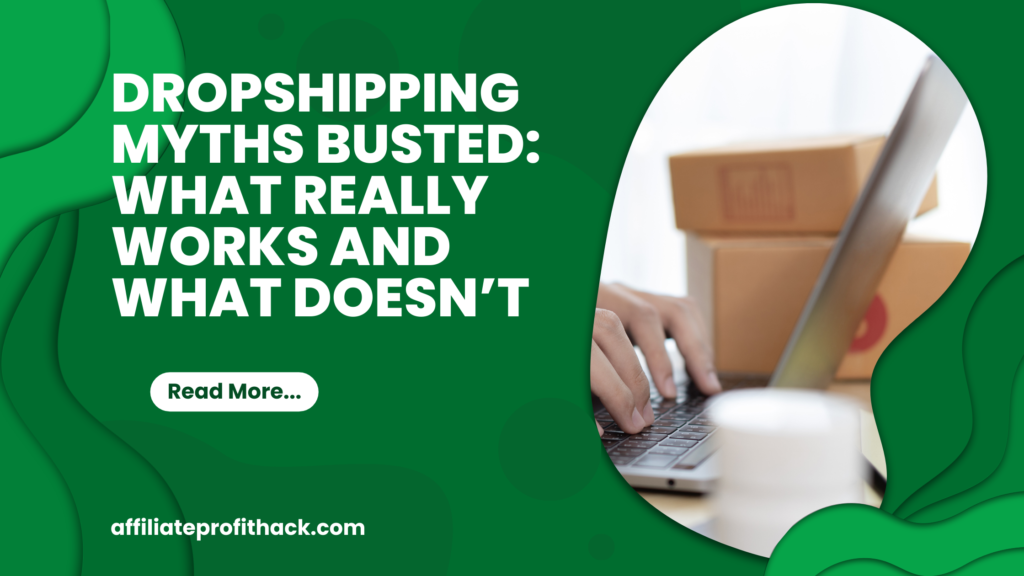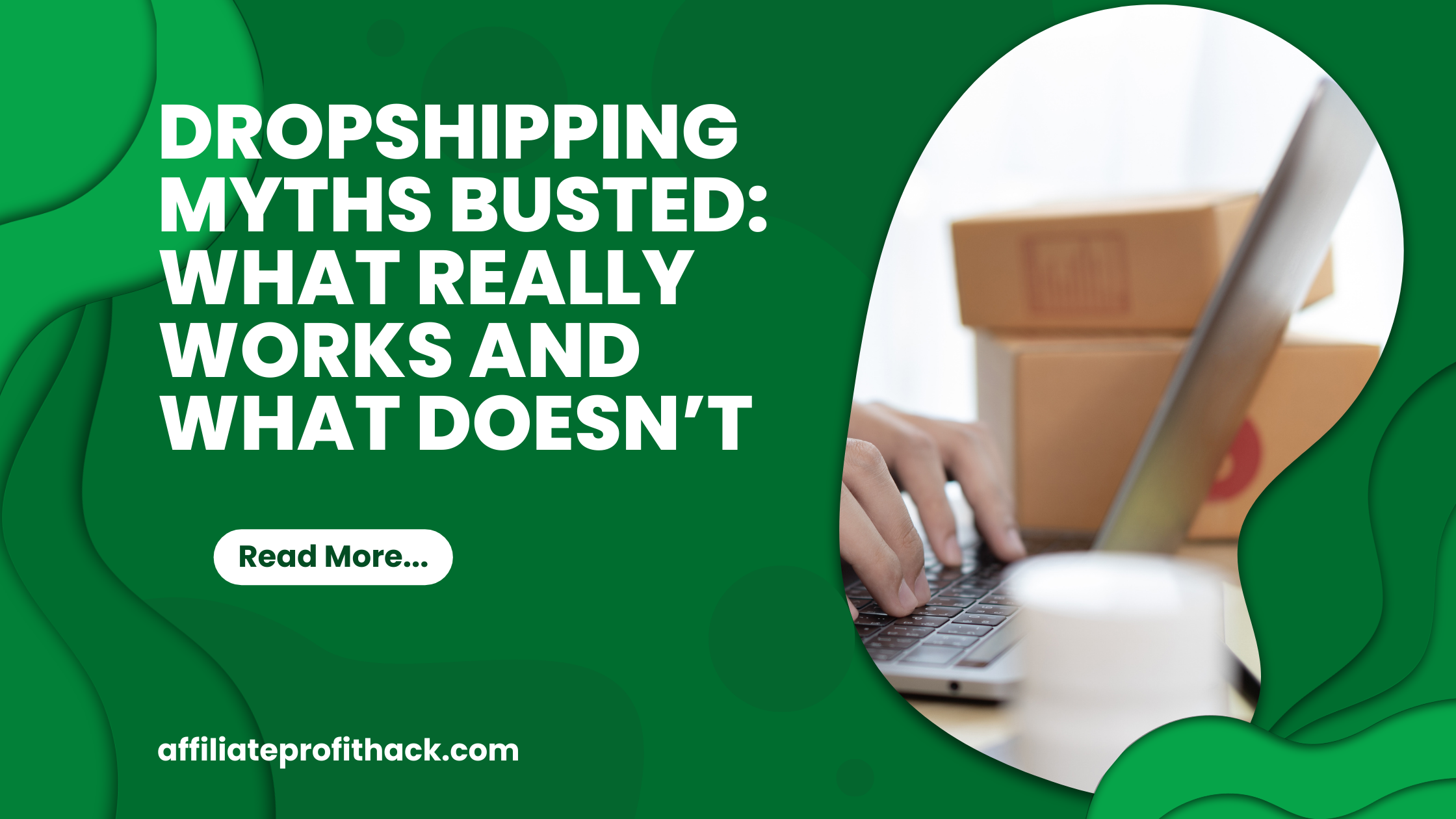Welcome to my article “Dropshipping Myths Busted: What Really Works and What Doesn’t”.
If you have spent any time in the e-commerce world (or even just scrolled through YouTube), you have probably come across the word “dropshipping” followed closely by promises of easy money, low effort, and maybe even a mansion in the background. Dropshipping is like the business world’s answer to a viral diet trend—everyone’s heard about it, a lot of people are trying it, and plenty of myths swirl around it. But just like you can’t lose weight by eating only donuts, you can’t build a dropshipping empire without facing a few hard truths.
In this article, we are pulling back the curtain on five of the biggest dropshipping myths to give you a clearer picture of what actually works. So whether you’re thinking about launching your first store or already knee-deep in product catalogs, read on. Let’s debunk the myths, set realistic expectations, and find out how you can make dropshipping work—with a healthy dose of reality on the side!
My Best Recommended & Proven Way to Make $100-$300 Daily – Watch This FREE Video to START >>>

Myth 1: Dropshipping Is a Quick and Easy Way to Make Money
This is probably the most popular myth floating around about dropshipping. If you’ve ever seen ads boasting that you can quit your day job by Tuesday and buy a sports car by Thursday, you’re not alone. The allure of fast money is real, but the reality? Well, let’s just say it’s a bit more complicated.
While it’s true that dropshipping doesn’t require a huge upfront investment, it’s far from a get-rich-quick scheme. Think of it less like a slot machine that’s just going to start spitting out cash and more like a very high-maintenance houseplant. Sure, the seeds are affordable, and it might look low-maintenance in your feed, but keeping it thriving requires ongoing attention and careful care. There’s niche research, supplier hunting, website design, product descriptions, marketing, customer service…and that’s just on Mondays.
In reality, most successful dropshippers spend months testing products, tweaking their ads, optimizing their websites, and experimenting with different suppliers before they see any serious revenue. And even then, it’s not “passive income”—it takes a continuous effort to stay competitive, monitor trends, and keep customers happy. So, if you’re looking to make money overnight with minimal effort, dropshipping isn’t the magic answer. But if you’re willing to put in the work and treat it like a real business, there’s definitely potential. Just leave those Lamborghini dreams on hold, at least for now!
Myth 2: You Don’t Need Much Money to Start Dropshipping
Dropshipping is often marketed as the ultimate low-budget business model, with some claiming that all you need is an internet connection and a cup of coffee to get started. While it’s true that you won’t need to buy a warehouse or keep stacks of inventory piled up in your garage, thinking you can start with spare change is a bit… optimistic.
Sure, the initial setup costs are lower than many other businesses, but let’s break down where the money actually goes. First, you’ll need a decent e-commerce platform, which usually comes with a monthly fee. Then, you’ll want a professional-looking website (because let’s be real, nobody’s buying from a site that looks like it was designed in 1998), which may require a small investment in themes or design tools. Don’t forget about product research tools, email marketing software, and perhaps even some paid ads to get the word out. And yes, even in a dropshipping model, there are occasional costs for product samples or dealing with refunds.
My Best Recommended & Proven Way to Make $100-$300 Daily – Watch This FREE Video to START >>>
Then there’s the real budget-eater: advertising. Most successful dropshipping stores rely heavily on paid ads, especially when starting out. The thing is, ads aren’t cheap—and they’re rarely a one-hit wonder. You’ll need to test different ads, monitor performance, and tweak your strategies, which can start to add up quickly. You may only need a few hundred dollars to open the doors, but a solid budget for testing and marketing is essential if you want to get your store off the ground.
So while dropshipping isn’t going to drain your bank account like a traditional retail store might, don’t expect to skate by on loose change. Think of it as a “low upfront investment” business, but one that will definitely test your budgeting skills if you want to scale. And remember, when the credit card bill arrives, that’s just business!
Myth 3: You Don’t Need to Worry About Inventory or Logistics
One of the biggest appeals of dropshipping is the promise of freedom from inventory and logistics. It sounds fantastic: no shelves stacked with products, no bubble wrap, no trips to the post office. Many people hear this and think they’re basically signing up to manage a digital vending machine—just sit back and let someone else handle the hard stuff. But, as with most things that sound too good to be true, there’s more to the story.
Sure, you’re not handling the physical products, but that doesn’t mean you can forget about inventory or logistics. When you’re running a dropshipping store, you’re still responsible for tracking stock levels—because if an item suddenly goes out of stock with your supplier, guess who has to explain to the customer why their dream product won’t be arriving? Spoiler alert: it’s you. To avoid awkward conversations and bad reviews, you’ll need to stay in close contact with your suppliers or even use inventory tracking tools to keep things smooth on your end.
Then there’s the matter of shipping times. Because you’re not keeping products on hand, you’re relying on suppliers to process and ship orders on time. And if your supplier is halfway around the world, this means that the “two-day shipping” expectation set by Amazon can become a bit of a stretch. You’ll likely deal with longer delivery times, potential customs delays, and the occasional “Where’s my package?” message from an impatient customer. Managing these expectations and providing clear communication about shipping times is key if you want happy (and returning) customers.
So while you may not be dealing with boxes directly, dropshipping isn’t a logistics-free zone. You’re still the one orchestrating the process from behind the scenes, ensuring that orders go out smoothly and managing the little surprises that come with global shipping. You might not need packing tape, but a little patience and some backup plans for logistical hiccups are absolutely necessary.
Myth 4: You Can Rely Entirely on Suppliers for Product Quality
When starting out in dropshipping, it’s easy to believe that your suppliers have got you covered when it comes to product quality. After all, they’re handling the sourcing, the packaging, and the shipping—so surely they’re ensuring that every item is top-notch, right? Well, let’s just say that sometimes the reality is more like “a surprise grab bag” than a “quality guarantee.”
Here’s the thing: when you’re not seeing, touching, or testing the products yourself, you’re putting a lot of faith in someone else’s quality control. Some suppliers are fantastic, providing high-quality items that look just like the product photos, but others… not so much. There are plenty of horror stories where a dropshipper thinks they’re selling luxurious satin pillowcases, only for customers to receive scratchy polyester that’s better suited as a cat bed. And in dropshipping, any quality slip-ups don’t fall back on the supplier’s reputation—they fall squarely on yours.
My Best Recommended & Proven Way to Make $100-$300 Daily – Watch This FREE Video to START >>>
To prevent these situations, you’ll want to take a proactive approach to quality control. Order samples from each supplier before you list products, check them over yourself, and see if they meet your standards. And even after that, keep a close eye on customer reviews and feedback. If you start getting complaints about a particular item, it’s time to dig deeper and possibly reconsider that supplier. Working with suppliers who can consistently deliver good quality might cost a little more upfront, but in the end, it’s worth it for happy customers and fewer refund requests.
So while your supplier is handling the actual product, it’s up to you to make sure they’re delivering what you’ve promised to your customers. Dropshipping without a hands-on approach to quality control is like selling mystery boxes—you might have some happy buyers, but you’re bound to have a few unpleasant surprises along the way. And when it’s your brand on the line, that’s a risk you definitely don’t want to take.
Myth 5: Dropshipping Is Too Saturated to Be Profitable
The classic “It’s too late, everyone’s already doing it” myth. With so many people jumping into dropshipping, it’s easy to feel like the market has been picked clean and all the profitable niches have been taken. After all, if every other Instagram ad seems to be peddling the same trending gadgets, where’s the room for you to make a splash? But here’s the truth: dropshipping isn’t “too saturated” if you’re smart about how you position yourself.
Yes, dropshipping has grown more competitive, and yes, some products are overexposed (we’re looking at you, “galaxy projector” lamps). But saturation only becomes a problem when everyone’s selling the same products in the same way, without any effort to stand out. The key to thriving in a crowded market is to approach it like a chef with a unique recipe—not just throwing out the same dish that everyone else is serving up. A carefully selected niche, paired with unique branding and smart marketing, can still go a long way toward carving out a profitable slice of the market.
One effective strategy is to focus on underserved or “micro” niches. While general fitness products are highly competitive, for instance, there are still plenty of smaller niches within that space, like products for specific workout types or audiences with unique needs. Research trending but less-saturated categories, dive into customer needs that aren’t being fully met, and consider adding a unique twist or value proposition to your store. Also, consider ways to build a brand around your store—rather than just listing random trending products, develop a style, tone, or even a mission that resonates with your audience.
In short, dropshipping can be profitable even in 2023 if you bring something fresh to the table. With a dash of creativity and a sprinkle of strategy, you’ll find that there’s still plenty of room to make your mark. And while you may not be the first to start selling LED strip lights or custom pet pillows, the good news is that you also don’t need to be the biggest seller to turn a solid profit.
Conclusion
So, there you have it—dropshipping myths busted, reality checks delivered. While it’s tempting to believe that dropshipping is a magical solution to making money online, the truth is a bit more… grounded. It’s a business model with a lot of potential, but it’s one that demands hard work, smart strategies, and a willingness to learn from mistakes (and there will be some). If you’re getting into dropshipping expecting a walk in the park, consider this your heads-up: it’s more like a hike. With hills. And maybe some unexpected weather.
The key takeaway? Approach dropshipping as a business, not a side hustle you can set on autopilot. Success here doesn’t come from overnight luck; it’s the result of researching your niche, building relationships with quality suppliers, investing in marketing, and putting in the hours to make sure your customers get what they’re promised. Sure, it might not be the glamorous “sit on the beach while the money rolls in” picture that some ads paint, but it can be rewarding. With patience and persistence, dropshipping can be a legitimate, profitable way to break into e-commerce.
My Best Recommended & Proven Way to Make $100-$300 Daily – Watch This FREE Video to START >>>
So go ahead, start with eyes wide open and realistic expectations. By understanding what dropshipping really entails and putting in the work, you’re setting yourself up for success in a way that gets past the hype and down to what truly works. And who knows? With the right strategy, a bit of resilience, and maybe just a pinch of luck, you might just find that dropshipping is the rewarding business venture you’ve been looking for—no mythical quick fixes required.
Thank you for reading my article “Dropshipping Myths Busted: What Really Works and What Doesn’t” till the end. Hope it helped you. See you with another article.










